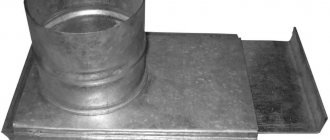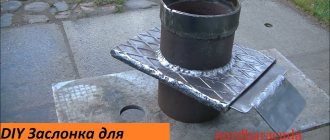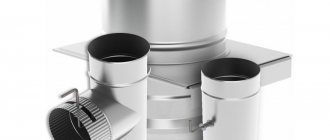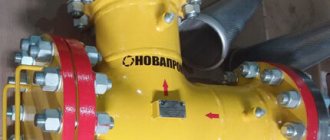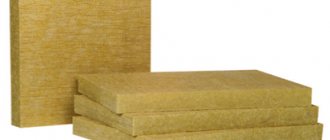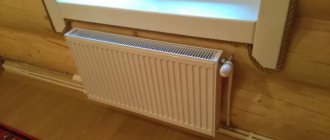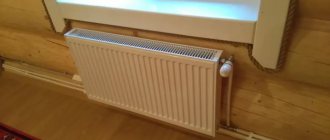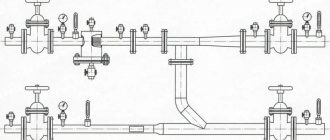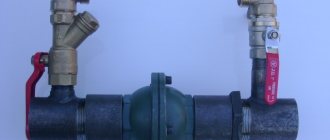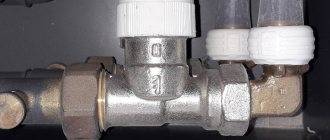The operating efficiency of a stove or fireplace largely depends on the draft force created in the pipe. The easiest way to regulate this parameter is to install a special damper. Let's look at what a chimney damper is, how it is designed and works, what it is intended for and what its functions are, what types exist and what are their features, as well as how to choose and install it correctly.
Retractable chimney damper made of stainless steel Source strojdvor.ru
Gate - what is it, device, purpose
A device designed to change the working cross-section of the smoke exhaust duct is called a damper. Simply put, this is a damper that reduces or increases the clearance of the chimney. With its help, the intensity of fuel combustion is regulated, and the draft after heating is blocked to preserve heat in the stove.
Traditionally, such a damper is mounted in the upper part of the stove chimney with access from inside the room and is a thin steel or cast iron plate that moves in one plane along a special frame. The principle of its operation is quite simple - in order to reduce or increase, completely open or close the working lumen of the smoke exhaust path, you need to push in or, conversely, pull out the plate. Another modification has a slightly different device and mechanism of action - rotary. The plate in such a device does not extend, but rotates around its axis.
The rotary gate is equipped with a special adjustment handle with position fixation Source static-sl.insales.ru
The gate control can be manual or electrically driven. This depends on the model, installation location and maintenance principle of the heating unit. Since such dampers are installed not only on basic brick or iron stoves and fireplaces, but also in the chimney systems of heating boilers and ventilation.
Functions
In most cases, the stove damper performs the following number of functions:
- Optimizes traction for weather conditions.
- Sets the intensity of fuel combustion, adjusting it to the needs of the consumer.
- Prevents the formation of hyperthrust during strong windiness.
- Promotes economical fuel consumption.
- Minimizes heat loss after heating.
- Protects the lower sections of the chimney from precipitation.
- When installed in a ventilation system, it prevents overheating of the motor.
Important! Closing the smoke exhaust channel with a damper must be carried out in a timely manner, but only after complete combustion of the fuel. Otherwise, if you close it too early, carbon monoxide, which is dangerous for all living things, will begin to enter the room, or if you close it too late, most of the heat will leave the firebox, and the stove will not be warm enough.
Scheme for installing a damper frame in a brick stove pipe
Advantages and disadvantages
The chimney damper has the following advantages:
- Possibility of adjusting the traction force.
- Effect on flame intensity.
- Rational fuel consumption.
- Better heat retention.
However, it has some disadvantages:
- Difficulty cleaning the chimney duct.
- Deterioration in the operation of the gate mechanism (jamming, decreased traction) due to improper installation.
- Correct adjustment requires some experience and skill.
If the installation requirements are met, the gate valve will last at least 10-15 years, and in ideal operating conditions - no less than the service life of the stove itself.
On a note! The more the valve is extended from the pipe or the rotating segment is at a stronger angle, the faster the combustion products will exit and the more intense the combustion.
Manufacturers
In addition to the products of the PromArm company discussed above, the following companies supply their products to the domestic market:
END Armaturen is a German manufacturer of high-quality gate valves made of steel and cast iron (GG-25) in closed housings, designed for pressures of 5, 6, 7, 8, 10 bar and working fluid temperatures up to 190 °C. The bidirectional products offered for sale with a U-shaped gate with diameters from 50 to 400 mm are produced with manual and lever control.
Zetkama, a well-known Polish manufacturer on the domestic market, supplies gate valves made of cast iron EN-GJL-250 with diameters from 50 to 1200 mm. The products are intended for use in pipelines transporting liquids with a 5% solids content, installations for supplying dry materials to the pulp and paper industry, and in sewerage systems with a 35% waste content. Gate valves are designed to operate at a working medium pressure of 2, 4, 7 and 10 bar and its temperature not exceeding 90 °C.
Rice. 15 Gate valve Zetkama
FAF Vana is a trademark of a Turkish manufacturer of a wide range of shut-off and control valves. FAF gate valves are produced in bodies made of ordinary or high-strength cast iron with diameters from 50 to 600 mm. All of them are designed for a working fluid pressure of 10, 16 bar and its temperature of no more than + 130 °C. Designed for use in environments containing clean and waste water, pulp, crystallized and powdery substances, and are used for transporting substances in the brewing and food industries.
CMO is a brand of a Spanish company with headquarters and production facilities in the city of Talos, founded in 1993.
The company supplies the domestic market with a very wide range of gate valves of various designs - more than 20 items with different letters. The fittings are produced from different materials with nominal diameters from 50 to 3000 mm with all types of drives. The pressure range of all products is from 0.5 to 100 bar, working media are gases, pure and with varying contents of suspended or solid liquid fractions.
Rice. 16 ABRA gate valve
ABRA is a trademark of a Chinese company, whose products are sold in Russia by Abradox. ABRA gate valves are produced with diameters from 50 to 600 mm for pressures of 4, 6, 10 and 16 bar. The product range includes several types of knife models of different sizes, the operating temperature of which depends on the type of seals used: for EPDM it ranges from - 10 to + 95 °C, for NBR this indicator is from - 10 to + 70 °C.
Tecofi is a trademark of a French company that produces the widest range of knife gate valves in the following series: standard VG, with a through knife (VGT), for dispensing hoppers (VGS), with a square knife (VGC), with a rectangular gate valve inclined at 30 degrees (VGA) ), airlock with a rectangular knife (VGM).
Tecofi gate valve body materials are regular and ductile iron, carbon steel, stainless steel, aluminum, polyvinyl chloride (PVC). Tecofi gate valves are produced with diameters from 50 to 1200 mm, their nominal pressures are 1, 2, 4, 7 and 10 bar; in special designs, the pressure characteristics can be 25 and 40 bar. The operating temperature for EPDM seals is 110 °C.
Rice. 17 Tecofi brand gate valve
Varieties
Furnace valves available on the market today are classified according to two criteria:
- Design : retractable and rotating.
- Material – cast iron and stainless steel.
Let's look at their features in more detail.
Rotary cast iron gate Source proroofer.ru
See also: Catalog of companies that specialize in engineering systems (heating, water supply, sewerage and others) and related work
Design
Based on the type of design, dampers are divided into two categories:
- Retractable.
Classic model of a furnace valve. The design is a metal plate moved in a special frame in a horizontal plane. Characterized by the following performance properties:
- Easy to use.
- Ease of installation.
- Durability.
- Reliability.
Mounted exclusively in a horizontal plane. Suitable for brick and steel stoves, fireplaces.
- Rotary or throttle.
The operating element of the rotary damper is a metal plate installed in the chimney and centrally fixed to a steel pin. With its help, fastening, actuation (rotation) and adjustment of the cross-section of the chimney duct are carried out.
In order to increase or decrease, respectively, to open or close the smoke exhaust passage, it is necessary to rotate the plate around its own axis at a given angle. As a rule, the model is less reliable than the classic version discussed above.
Throttle valve for steel chimney Source cloudinary.com
The main disadvantage is the burnout of the contact connecting the plate to the fastening pin, and, as a result, disruption of the functions of the valve. It is most often installed in steel chimney systems.
Material
Based on the type of material, furnace valves are divided into two types:
- Cast iron.
Products made of cast iron are strong, reliable and durable. Their only drawback is their heavy weight. This somewhat complicates the installation procedure, and also imposes strict requirements on the base. Therefore, most often cast iron valves are installed on brick chimneys.
As a rule, sliding-type dampers are made of cast iron, but there are also rotary varieties. Their main area of application is classic stoves and fireplaces made of brick.
- Made of stainless steel.
The chimney gate valve based on a stainless steel alloy differs from the above modification in being lighter in weight. This somewhat simplifies the requirements for the strength of the base, and makes it possible to install them in steel chimney pipes of furnaces, heating or ventilation equipment.
The stainless steel gate is lightweight and durable Source prom.st
Drive types
Depending on the size and purpose of the pipeline on which the gate valve is installed, different forces are required to change the position of the control element - the greater the throughput of the pipes and the higher the density of the working medium, the more difficult it is to open and close the valve.
Therefore, various options for controlling the mechanism are used for adjustment:
- The valves with a small internal diameter, installed on pipelines transporting liquid and gaseous working media of low density without hard particles, are controlled manually - using a handle, screw or lever.
- The electric drive allows you to precisely regulate the throughput of the unit without the application of physical force. Electrically driven gate valves can be used on large pipelines and to regulate the flow of viscous and granular working media. The only drawback of such a mechanism is its energy dependence.
- The pneumatic actuator drives the rod and locking mechanism using a compressed gas turbine, the operation of which is similar to that of a conventional pump. The strength of pneumatic control is that the entire control mechanism from the rod to the pneumatic turbine is located outside the valve body and does not come into contact with the working environment, which increases the service life of the device.
Pneumatically driven valves are the most complex and expensive. It is installed on pipelines that require remote adjustment, but the design of the control mechanism is such that, if necessary, manual adjustment is possible, which, thanks to the pneumatic turbine, does not require much physical force.
Criterias of choice
In order to choose the right valve for a chimney pipe for specific application conditions, it is necessary to take into account the following number of parameters:
- Conditions of use . It is not recommended to equip a sauna stove with a rotary damper.
A sliding gate valve is ideal for equipping a stove in a bath Source parma.center
- Frequency of operation . For stoves used periodically or seasonally, it is better to install a pull-out valve. If you choose a throttle model, the chimney above the plate will constantly become damp, since when closed it still allows damp air to pass through, and below it a large amount of soot will accumulate during combustion.
- Type of equipment . To equip combustion product removal systems for gas heating boilers, it is recommended to use a throttle valve. Since the design ideally complies with the technical conditions, according to which the channel cross-section should not overlap by more than 40%.
In addition, when choosing a damper, you must make sure that its dimensions exactly match the cross-sectional area of the chimney channel into which it will be installed.
The dimensions of the gate must exactly match the diameter of the pipe Source parmaster.ru
Methods of use
Gate valves with a gate design are used in treatment and filtering installations and various pipelines (usually of the “dirty” type). This means that durable and reliable dampers do an excellent job of blocking the movement of powerful mud flow. They can be installed on pipelines carrying high pressure
refers to rock, oil, all kinds of liquids with granules, pulp and other impurities, solid inclusions and particles.
Based on the diverse range of pumped media, gate valves are classified into models intended for use in various industries. In particular, the most popular areas of use of such valves are:
- chemical industry;
- oil and gas industry;
- production of building materials;
- public utilities;
- mining industry;
- pulp and paper industry;
- electric power and so on.
Gate valves, due to their ability to filter and crush particles passing through it, as well as to pass large volumes of working fluid, are widely used and used in sewer systems and drains. They are also quite in demand for chemical plants, where they are equipped with technological lines for the production of ammonia, mastics, acids and all kinds of mineral fertilizers. In the mining industry, gate valves help filter and dispense useful components, preparing them for subsequent processing.
A separate area of application, which is regulated by regulatory documentation GOST 55020-2012, is the oil and gas industry. In this area, gate valves are used on main pipelines as part of Christmas tree fittings
Installation Features
Installation of a damper on a chimney is possible in 3 main options:
- In a straight chimney above the firebox . The method is suitable for fireplaces and stoves with summer operation. The valve is located approximately 1 meter from the combustion chamber. The main advantage is accessibility and ease of maintenance.
- " Pipe to pipe ." The method involves installing a damper into the chimney duct without additional fastening devices.
- Installation in a ventilation system . Used to protect the fan motor from overheating.
Deflector for the chimney pipe (with photo)
To eliminate backdraft in the chimney, it is recommended to use a deflector.
>
Look at the photo: the chimney deflector is a mechanical fan that sucks smoke from the chimney shaft.
It is also necessary to look at how the gate is located - a special valve with which the draft is controlled. One damper should be located in the chimney duct, and the second, as a rule, is located either in the stove or in its door. You can try changing their position.
Modern deflectors for stoves are:
with a flat top;
equipped with an opening lid;
having a gable roof with two slopes on the pipe;
with a semicircular top.
Deflectors with a flat copper top are often located in Art Nouveau style baths.
Basically, sheets of galvanized iron are used to make deflectors, although recently you can often find deflectors on sale in which the metal is coated with enamel or even a layer of plastic.
Some models of deflectors must be inserted with the door facing the smoke collector. To do this, you need to place one edge on the wall, carefully lift the second and lower it into place. For ease of installation, the plates should be removed from the rear and side walls.
You can choose a model in a store, or you can easily make a chimney deflector yourself. Before making a deflector for a pipe, read the detailed description of the stages of work.
Before you begin directly making the deflector, you need to decide on the material from which it will be made. It can be copper, galvanized iron or stainless steel. Despite the fact that copper is a fairly expensive material, it is better to opt for this metal, as it is resistant to atmospheric conditions. This is due to the fact that the deflector is located in one of the most inaccessible places in the bathhouse, and frequent repairs will be problematic.
Before making the deflector, it is necessary to draw on cardboard a development of all the main parts, including the cap, diffuser and outer cylinder. Then you should transfer everything to metal and cut according to these patterns using special scissors. Next, you need to connect the parts to each other using rivets, bolts or welding. From a strip of metal you need to make brackets with which the cap will be fixed to the surface. A reverse cone should be attached to the cap. Having assembled the deflector onto the chimney pipe, you can proceed to installing it on the roof. First you need to fix the lower cylinder using bolts and nuts. Using clamps, you need to secure the diffuser to the lower cylinder, and install a cap with a reverse cone on it.
Video description
Video example of installing a damper in a chimney of a brick kiln:
When installing a damper in a pipe, the following series of problems and errors may arise:
- Installation of the valve in a part of the chimney duct with external thermal insulation. As a result, the mechanism will overheat and jam.
- Installation of a cast iron model in a steel pipe. Under the influence of the large weight of the damper, the chimney is deformed.
- A poorly made valve is made of thin metal. Such a product will quickly burn out or bend under heat.
- An uneven internal surface of the gate will lead to frequent jamming and poor-quality operation.
- A valve plate without a technological hole (for easy purging to avoid the accumulation of carbon monoxide in the furnace), necessary to comply with safety regulations.
- Installation of rotary models with adjustment handles that do not make it possible to control the position of the sliding plate.
Advice! To extend its service life and trouble-free operation, the damper must be cleaned regularly. The retractable plate and guides must be periodically lubricated with a special anti-corrosion compound. The rotary analogue requires cleaning through the chimney with a special brush.
Adjustment
When operating heating units, an important aspect is the correct adjustment of the traction force, which affects the efficient operation and safety of the heating system. The sliding element, even with full penetration into the chimney channel, does not completely protect the bathhouse from the penetration of carbon monoxide. Closing is carried out after the end of the firebox, the firewood should have time to burn out and become covered with an ash layer.
If this is not followed, there is a risk of inhaling harmful gaseous substances. As carbon monoxide leaks out, it fills the room. It should be remembered that installing draft control devices (vane, deflector, weather vane) does not exempt you from regular cleaning of the pipe. If equipment is not cleared of soot in time, unpleasant consequences cannot be avoided.
It is necessary to carefully monitor the condition of the chimney structure and the presence of sufficient draft force.
To control traction, a formula has been developed for calculating the optimal value for the gate element, which is called the “alpha” coefficient. When setting the required value, uniform combustion of wood materials is ensured with minimal ash formation.
Briefly about the main thing
The damper is a special damper installed in the pipe and allows you to reduce or increase the working cross-section of the chimney duct. By design, it can be retractable and rotary. Its main functions are optimizing draft, adjusting flame intensity, preventing hyperdraft, saving fuel, protecting the stove from heat loss, protecting the chimney from precipitation.
The main advantages of the damper are the ability to adjust the traction force, influence on the intensity of combustion, rationalization of fuel consumption, and heat conservation. The disadvantages are associated with difficulties during cleaning the chimney duct, operational problems due to improper installation and the need for special skills for maintenance.
Furnace dampers are divided into the following types:
- By design - retractable and rotary.
- By type of material - cast iron and stainless steel.
Each of them has its own nuances and areas of application. When choosing, you need to take into account the type of stove, heating unit or ventilation system in which it will be installed, as well as compliance with the dimensions of the smoke exhaust duct. Installation of the damper is possible in 3 options - directly above the chimney, “pipe to pipe”, in the ventilation. Installation is carried out in stages. In this case, you need to take into account the features and possible errors.
The design of a gate valve and materials for its manufacture
The main components of a typical gate valve are:
Frame. It consists of a main part and a cover (in many designs it has a stand with a yoke assembly), connected to each other with bolts. The main materials for the manufacture of body parts are carbon steel grade WCB (analogues of cast steel 20L, 25L, 30L), stainless steel (for example 20Х13, CF8, CF8M, AISI 304, AISI 310, AISI 316), gray (SCh20, SCh25) and high-strength nodular cast iron (ductile iron) grades GG-40 or GG-25.
Exclusive case materials include aluminum, bronze and AISI 904L uranium.
Typically, valve bodies are coated with a blue epoxy or powder-epoxy compound approximately 250 microns thick.
Shiber. Most often, the gate plate is made of corrosion-resistant metal alloys, which are AISI 304, AISI 310 or AISI 316 stainless steel.
Spindle. The element is responsible for moving the bolt plate, usually made of stainless steel (20X13).
Rice. 4 Materials for the manufacture of seals in SMO brand products and their varieties
Seat seals. Main materials of seat seals in gate valves:
EPDM - ethylene-propylene-diene elastomer (EPDM) is used as a sealant when transporting media with an operating temperature of + 90 °C and a maximum temperature of no more than + 125 °C.
NBR is acrylic-nitrile-butadiene rubber, it has a relatively low heat resistance with a maximum threshold of no more than + 90 ° C; when using it, the temperature of the working environment should not be higher than + 80 ° C.
Viton (FKM, FPM) is a class of synthetic fluorinated rubbers (SFK), which have a maximum temperature threshold of + 200 °C, and can be operated for a long time at a temperature of + 180 °C.
PTFE is a well-known white fluoroplastic with a soapy surface to the touch. The material has a very low coefficient of friction and the highest heat resistance among all seals at + 270 ° C. It is mainly used as an oil seal; when used in seats, fluoroplastic does not provide 100% sealing.
Nitrile (Nitril) is a synthetic butadiene-nitrile rubber (rubber), resistant to petroleum products, oils, acids and low concentration alkalis. Withstands operating temperatures up to + 90 °C.
Hypalon (CSM) is a product from DuPont that is a chlorosulfonated polyethylene elastomer (CSPE). Hypalon is a general purpose rubber with good mechanical properties and high resistance to abrasion, wear and aggressive chemicals. The maximum temperature threshold for CSPE-based rubber reaches + 120 °C.
Silicone - organosilicon silicone rubber is an elastic material that can function in the temperature range from - 60 to + 300 ° C (withstands 500 hours). The maximum operating temperature of silicone rubber with a service life of 20 years is + 120 °C. Silicone is resistant to oxidizing agents, oils and organic solvents, has a low coefficient of residual deformation, that is, it easily restores its shape. The disadvantages of organosilicon silicone rubber include its insufficiently high tensile strength compared to other elastomers.
Rice. 5 Design of gate valves according to GOST R 55020-2012
Oil seal packing. In gate valves, the gland provides a seal in the body of a moving flat plate and has an internal surface shape corresponding to an elongated rectangular gate. The following materials are used as its packing and ring gaskets:
- Dry cotton fiber, used in general purpose installations working with solid bulk materials.
- Oiled cotton fiber. It consists of woven threads impregnated with grease. Is a packing for standard shut-off valves operating under pressure.
- Cotton Fiber with PTFE is a general purpose padding made from woven Teflon-impregnated cotton fibers.
- Teflon acrylic fiber. It is a synthetic acrylic thread impregnated with Teflon using vacuum dispersion technology. It is a typical packing for valves operated under pressure in aggressive liquids (oils, oxidizers, alkalis and acids) or with suspended particles.
- Fibrous (lubricated) PTFE. Fluoroplastic fibers with a diagonal weave system can function at high speeds of gate movement in almost any aggressive environment, including those containing solid fractions.
- Heat-resistant graphite fiber is a diagonally woven thread impregnated with a lubricant made from a similar material. The packing is universal, as it can withstand not only high temperatures of vapors, gases and liquids, but also their aggressive chemical composition. Graphite is not afraid of oils, solvents, the vast majority of alkalis and acids.
- Ceramic fiber is used in gate valves that handle high temperature air or gases at low pressures.
- PTFE, nitrile and EPDM are used as rectangular gaskets.
